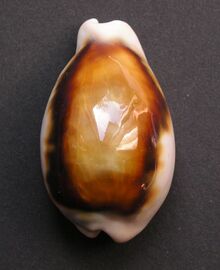Biology:Neobernaya spadicea
| Neobernaya spadicea | |
|---|---|

| |
| A live Neobernaya spadicea, in situ, mantle partly extended, head end to the right | |

| |
| An apertural view of a shell of the species, anterior end to the left | |
| Scientific classification | |
| Kingdom: | |
| Phylum: | |
| Class: | |
| Order: | |
| Superfamily: | |
| Family: | |
| Genus: | |
| Species: | N. spadicea
|
| Binomial name | |
| Neobernaya spadicea (Swainson, 1823)
| |
| Synonyms | |
| |
Neobernaya spadicea, common name the chestnut cowrie, is a species of sea snail in the cowrie family, Cypraeidae. Chestnut cowries can be found in the eastern Pacific Ocean, from central California to Baja California. The chestnut cowrie has a highly glossy shell due to an enamel that is secreted from its mantle.
Distribution and habitat
The chestnut cowrie is the only species of cowrie in the eastern Pacific Ocean.[1][2] It can be found in intertidal zones from Monterey, California to Isla Cedros, Baja California.[2][3] It is common in Southern California, specifically around the Channel Islands.[1][3] Chestnut cowries are rare in the portion of their range that is north of Santa Barbara, California.[4][3]
Chestnut cowries live in kelp beds and rocky surfaces in intertidal and subtidal zones,[4][5] to a depth of 45 m.[2] Chestnut cowries are often found under rocks and protected crevices.[4][5]
Description
The top of the shell displays a large irregularly shaped caramel colored spot, with a dark brown border.[4] The rest of the shell is white, including the bottom.[4] There is a narrow aperture with small teeth that spans the length of the underside of the shell.[6] The shell can grow until the cowrie reaches its adult form, then it stops.[5] When undisturbed, their orange spotted mantle extends around the outside of the shell; when fully extended it can completely cover the shell.[4][5] The shell is glossy due to an enamel that is secreted from the edges of the mantle.[4] Retracting and extending the mantle acts as a buffer, shining the shell while depositing new enamel.[4] The foot of this species is white.[4] The adult shell of this species ranges in size from 40 to 65 mm.[1]
Ecology
Diet
The chestnut cowrie is a scavenger and carnivore; common food items include anemones, sponges, tunicates, eggs, and dead organisms.[2][3]
Reproduction
Chestnut cowries lay batches of eggs during the summer months.[3] Each batch consists of approximately 100 egg capsules with each egg capsule containing several hundred eggs.[3]
References
- ↑ 1.0 1.1 1.2 McLean, James H. (1978). Marine Shells of Southern California. Natural History Museum of Los Angeles County. ISBN 978-0-938644-03-3.
- ↑ 2.0 2.1 2.2 2.3 Gotshall, Daniel W. (2005). Guide to Marine Invertebrates: Alaska to Baja (2nd ed.). Monterey: Sea Challengers. ISBN 0-930118-37-5.
- ↑ 3.0 3.1 3.2 3.3 3.4 3.5 Sept, J. Duane (2002). Beachcomber's guide to seashore life of California. Madeira Park, B.C.: Harbour Pub. ISBN 1550172514. OCLC 48579658.
- ↑ 4.0 4.1 4.2 4.3 4.4 4.5 4.6 4.7 4.8 Sheldon, Ian (2007). Seashore of Southern California. Auburn: Lone Pine Publishing. pp. 83. ISBN 978-1-55105-232-8.
- ↑ 5.0 5.1 5.2 5.3 Hinton, Sam (1987). Seashore Life of Southern California. Berkeley: University of California Press. pp. 105–106. ISBN 0-520-05923-9.
- ↑ Morris, Percy A. (1966). A field guide to Pacific coast shells, including shells of Hawaii and the Gulf of California (2d ed., rev. and enl ed.). Boston: Houghton Mifflin. ISBN 0395080290. OCLC 700828. https://archive.org/details/fieldguidetopaci00morr.
Wikidata ☰ Q3006698 entry
 |



